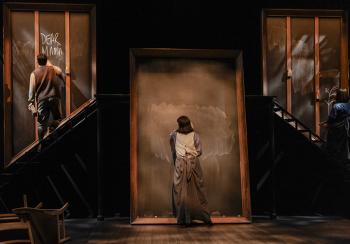Image Caption
Summary
Local Journalism Initiative Reporter
Windspeaker.com
Update Oct. 28, 2024 at 7 a.m. (Alberta): The claim of Métis identity by playwright Jani Lauzon has been called into question in an article by Michelle Cyca published in “The Walrus” Oct. 28 titled An Acclaimed Canadian Playwright Faces Questions of Pretendianism. View article here: https://thewalrus.ca/an-acclaimed-canadian-playwright-faces-questions-o…
A play about a fictional residential school in northern Ontario is currently in previews and will have its world premiere on Sept. 11 at the Studio Theatre in Stratford, Ont.
The play, titled 1939, was co-written by Jani Lauzon, a Métis playwright, and Kaitlyn Riordan, who is non-Indigenous. Both Lauzon and Riordan live in Toronto.
The play takes the audience back to the year 1939 when five students of a residential school are anticipating a visit from King George VI, Queen Elizabeth’s father.
Students at the school will perform All’s Well That Ends Well by William Shakespeare for the king, but they balk at the ideas of how it should be performed. Reluctant to be defined by colonial expectations, the five Indigenous students are keen to put their own spin on the play and find connections to their own realities.
Lauzon is hoping one of the play’s takeaways will be that audiences become aware of the resilience of the students and how strong and witty they were.
“It’s really about myth busting for me as well, in terms of non-Indigenous audiences,” Lauzon said. “It’s just to bust some myths because we wanted to shine a light on how resilient the students had to be in order to survive and what they did in order to survive.
“The one big myth I just want to bust up and just throw some dynamite at was this belief system that we were incapable of love and loving our children. And, if anything, I hope it’s one thing audiences really come away with is the ability to bust that myth.”
Riordan said she and Lauzon wrote the play for a range of audiences.
“First and foremost, I hope the work honours survivors,” Riordan said. “That is my Number 1 hope for the work, for survivors, for intergenerational survivors and for those who didn’t survive and their families. My further hope to that is also that people like me who didn’t learn about this history in school will go away with more knowledge and that knowledge will be tied to these incredible characters, these five students, who wound their way into their hearts for a couple of hours.”
The play will run until Oct. 29. Tickets are available at www.stratfordfestival.ca
“Kaitlyn and I have been working with Stratford to reach as many Indigenous communities as possible,” Lauzon said. “Our goal and our desire is to have in the audience Indigenous and non-Indigenous people sitting side by side. And it’s going to take some time to develop those relationships. As an organization Stratford is going to have to be committed to the long-term goal of making that happen.”
A positive step towards that goal is the fact a space for reflection is available next to the Studio Theatre for audiences following performances of 1939.
The reflection space features an installation by Tom Wilson titled Fading Memories of Home. It wasn’t until his 50s that Wilson, a Mohawk musician, artist and writer, found out many of the details of his Indigenous ancestry.
A reflection space had also been available last year following Stratford Festival performances of The Rez Sisters.
Lauzon said festival officials were keen to include the space again after 1939 performances this year.
Stratford brought back Wilson's "beautiful exhibition" of a series of wooden desks that were specially made with photographs of his family embedded in them, Lauzon said. “And then there is a video component on a video screen in the shape of a chalk board and then two paintings that he’s done side by side. It’s a beautiful extension I would say.”
Kelly Fran Davis, a Six Nations member who is a professor of Indigenous histories and cultures at Wilfrid Laurier University, facilitates discussions in the reflection space.
“She’s really amazing in leading discussions around very complicated issues of Indigenous and non-Indigenous relationships,” Lauzon said.
In a news release promoting 1939, Lauzon said: “We are having conversations around Cultural Intimacy and using circular communication to transform the way we create theatre.”
Lauzon said she chose the phrase ‘cultural intimacy’ to describe the process of conversations around reconciliation.
She said the theatre world has various ways of supporting sexual intimacy in pieces.
“What we don’t have is how do we talk about the content of cultural specificity and how do we find ways to talk about that to best support the theatre projects that we’re working on,” she said. “Especially when there is a combination of Indigenous and non-Indigenous actors. So, I’ve just coined this phrase ‘cultural intimacy’ because I want to start to shine more focus on the importance of that.”
As for circular communication, Lauzon explained that in theatre there is often a separation between all of the departments that work on a play.
“What I like to do is bring everybody that is part of the project in, especially on the first day, so that we all have a chance to just sit together in circle and to really get to know each other and to understand how everyone intersects with the play,” she said. “And by doing so we get a sense of the fulsome of the team and who is in involved.”
Local Journalism Initiative Reporters are supported by a financial contribution made by the Government of Canada.

